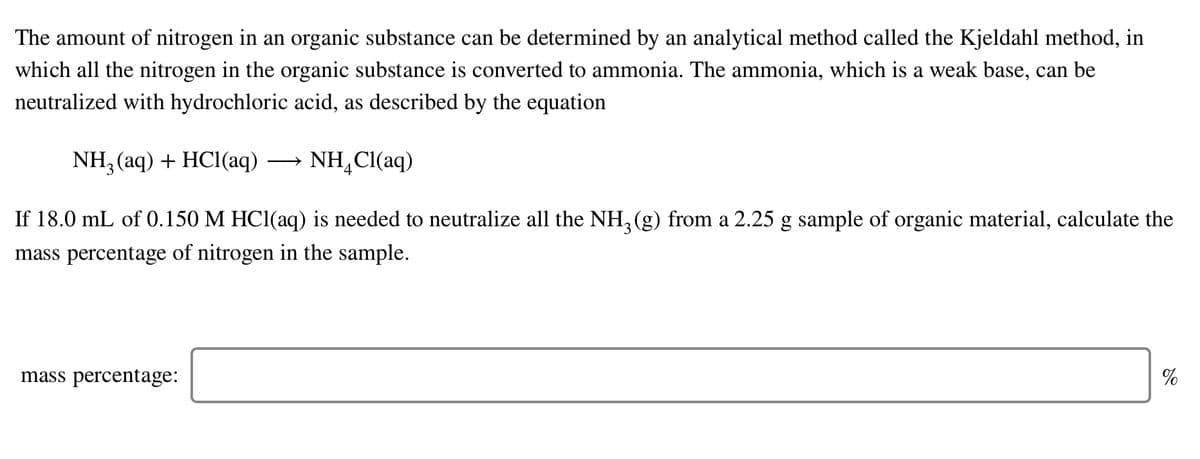The amount of nitrogen in an organic substance can be determined by an analytical method called the Kjeldahl method, in which all the nitrogen in the organic substance is converted to ammonia. The ammonia, which is a weak base, can be neutralized with hydrochloric acid, as described by the equation NH, (aq) + HCl(aq) NH,CI(aq) If 18.0 mL of 0.150 M HCI(aq) is needed to neutralize all the NH, (g) from a 2.25 g sample of organic material, calculate the mass percentage of nitrogen in the sample. mass percentage: %
The amount of nitrogen in an organic substance can be determined by an analytical method called the Kjeldahl method, in which all the nitrogen in the organic substance is converted to ammonia. The ammonia, which is a weak base, can be neutralized with hydrochloric acid, as described by the equation NH, (aq) + HCl(aq) NH,CI(aq) If 18.0 mL of 0.150 M HCI(aq) is needed to neutralize all the NH, (g) from a 2.25 g sample of organic material, calculate the mass percentage of nitrogen in the sample. mass percentage: %
Chemistry: Principles and Practice
3rd Edition
ISBN:9780534420123
Author:Daniel L. Reger, Scott R. Goode, David W. Ball, Edward Mercer
Publisher:Daniel L. Reger, Scott R. Goode, David W. Ball, Edward Mercer
Chapter16: Reactions Between Acids And Bases
Section: Chapter Questions
Problem 16.77QE
Related questions
Question

Transcribed Image Text:The amount of nitrogen in an organic substance can be determined by an analytical method called the Kjeldahl method, in
which all the nitrogen in the organic substance is converted to ammonia. The ammonia, which is a weak base, can be
neutralized with hydrochloric acid, as described by the equation
NH, (aq) + HCl(aq)
NH,Cl(aq)
If 18.0 mL of 0.150 M HC1(aq) is needed to neutralize all the NH,(g) from a 2.25 g sample of organic material, calculate the
mass percentage of nitrogen in the sample.
mass percentage:
%
Expert Solution
This question has been solved!
Explore an expertly crafted, step-by-step solution for a thorough understanding of key concepts.
This is a popular solution!
Trending now
This is a popular solution!
Step by step
Solved in 2 steps with 2 images

Knowledge Booster
Learn more about
Need a deep-dive on the concept behind this application? Look no further. Learn more about this topic, chemistry and related others by exploring similar questions and additional content below.Recommended textbooks for you

Chemistry: Principles and Practice
Chemistry
ISBN:
9780534420123
Author:
Daniel L. Reger, Scott R. Goode, David W. Ball, Edward Mercer
Publisher:
Cengage Learning

General Chemistry - Standalone book (MindTap Cour…
Chemistry
ISBN:
9781305580343
Author:
Steven D. Gammon, Ebbing, Darrell Ebbing, Steven D., Darrell; Gammon, Darrell Ebbing; Steven D. Gammon, Darrell D.; Gammon, Ebbing; Steven D. Gammon; Darrell
Publisher:
Cengage Learning

Chemistry & Chemical Reactivity
Chemistry
ISBN:
9781337399074
Author:
John C. Kotz, Paul M. Treichel, John Townsend, David Treichel
Publisher:
Cengage Learning

Chemistry: Principles and Practice
Chemistry
ISBN:
9780534420123
Author:
Daniel L. Reger, Scott R. Goode, David W. Ball, Edward Mercer
Publisher:
Cengage Learning

General Chemistry - Standalone book (MindTap Cour…
Chemistry
ISBN:
9781305580343
Author:
Steven D. Gammon, Ebbing, Darrell Ebbing, Steven D., Darrell; Gammon, Darrell Ebbing; Steven D. Gammon, Darrell D.; Gammon, Ebbing; Steven D. Gammon; Darrell
Publisher:
Cengage Learning

Chemistry & Chemical Reactivity
Chemistry
ISBN:
9781337399074
Author:
John C. Kotz, Paul M. Treichel, John Townsend, David Treichel
Publisher:
Cengage Learning

Chemistry & Chemical Reactivity
Chemistry
ISBN:
9781133949640
Author:
John C. Kotz, Paul M. Treichel, John Townsend, David Treichel
Publisher:
Cengage Learning

Chemistry for Engineering Students
Chemistry
ISBN:
9781337398909
Author:
Lawrence S. Brown, Tom Holme
Publisher:
Cengage Learning

Chemistry: Principles and Reactions
Chemistry
ISBN:
9781305079373
Author:
William L. Masterton, Cecile N. Hurley
Publisher:
Cengage Learning